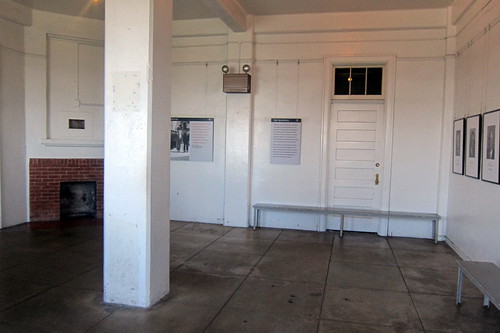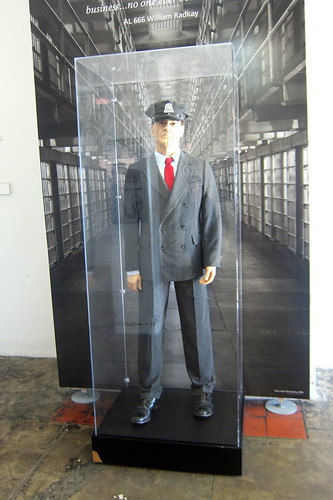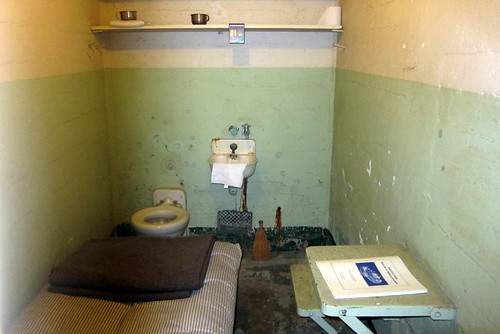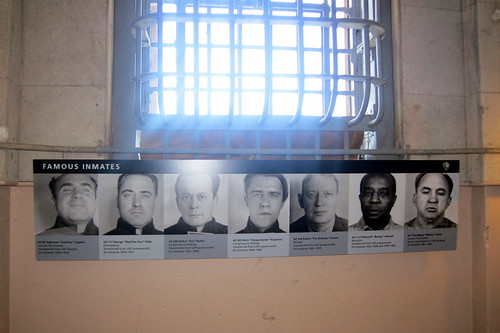San Francisco - Alcatraz: Cellhouse - Warden's Office
Image by wallyg
The main cell house on Alcatraz Island was the largest steel-reinforced concrete building in the world when it was built in 1912. Designed to hold up to 600 prisoners, it was the brainchild and pride of Major Reuben B. Turner, construction engineer and first commandant of the military. Central steam heat, skylights and electricity contributed to its reputation as a model, modern, facility.
Like any other structure on the island, construction presented challenges. Material and equipment had to be shipped in on barges. Mixing cement, the main building element, required fresh water not naturally available on the land. Labor was largely provided by unskilled inmates.
Like prisons within a prison, four free standing cellblocks stood within the cellhouse so that no cell adjoined an outside wall or ceiling that a prisoner might tunnel through. Before it assumed its role as a maximum-security lockup, tool-proof bars replaced the flat, soft-steel barriers of the military prison and gun galleries were built at either end of the two main cell blocks.
Alcatraz Island, a 22-acre island located 1.5 miles offshore in San Francisco Bay, has served as a lighthouse, a military fortification, and a prison. In 1972, the island often referred to as The Rock, became a national recreation area operated by the National Park Service as part of the Golden Gate National Recreation Area (GGNRA) and is currently open to tours.
The island was first discovered in 1775 by Spaniard Juan Manuel de Ayala, who charted the bay and named it "La Isla de los Alcatraces," or "The Island of the Pelicans." The island's earliest recorded owner is Julian Workman was the island's earliest recorded owner, given it by Mexican governor Pio Pico in 1846 to build a lighthouse. Following the acquisition of California in 1848, the United States fortified the island for positioning of coastal batteries. When the civil War broke out in 1861, the island mounted 85 cannons (increased to 105 by 1866) and served as the San Francisco Arsenal. Alcatraz never fired its guns but was used to imprison Confederate sympathizers. In 1867, a brick jailhouse was built and in 1868, Alcatraz was designated a long-term detention facility for military prisoners--a role it prominently played during the Spanish-American War.
After the 1906 Earthquake, civilian prisoners were transferred to Alcatraz, and the facilities were slowly expanded at the beginning of the century. Construction on Major Reuben Turner's huge concrete main cell block was completed in 1912. The Fortress was deactivated as a military prison in 1933 and transferred to the Department of Justice, becoming a Federal Bureau of Prisons federal prison the following year. During its 29 years of operation, the penitentiary claimed no prisoners had ever successfully escaped--36 prisoners were involved in 14 attempts; 23 were caught, six were shot and killed, and three were lost at sea and never found. Alcatraz held such notable criminals as Al Capone, Robert Franklin Stroud (better known as the "Birdman of Alcatraz"), George "Machine Gun" Kelly, James "Whitey" Bulger, and Alvin "Creepy Karpis" Karpowicz (who served more time at Alcatraz than any other inmate).
Far more expensive to operate than other prisons, Alcatraz was closed on March 21, 1963 by Attorney General Robert F. Kennedy. From 1969-1971, the island was occupied by a multi-tribal group of Native Americans, culminating in the Trail of Broken Treaties.
National Register #76000209 (1976)
San Francisco - Alcatraz: Cellhouse - Prison Guard
Image by wallyg
The main cell house on Alcatraz Island was the largest steel-reinforced concrete building in the world when it was built in 1912. Designed to hold up to 600 prisoners, it was the brainchild and pride of Major Reuben B. Turner, construction engineer and first commandant of the military. Central steam heat, skylights and electricity contributed to its reputation as a model, modern, facility.
Like any other structure on the island, construction presented challenges. Material and equipment had to be shipped in on barges. Mixing cement, the main building element, required fresh water not naturally available on the land. Labor was largely provided by unskilled inmates.
Like prisons within a prison, four free standing cellblocks stood within the cellhouse so that no cell adjoined an outside wall or ceiling that a prisoner might tunnel through. Before it assumed its role as a maximum-security lockup, tool-proof bars replaced the flat, soft-steel barriers of the military prison and gun galleries were built at either end of the two main cell blocks.
Alcatraz Island, a 22-acre island located 1.5 miles offshore in San Francisco Bay, has served as a lighthouse, a military fortification, and a prison. In 1972, the island often referred to as The Rock, became a national recreation area operated by the National Park Service as part of the Golden Gate National Recreation Area (GGNRA) and is currently open to tours.
The island was first discovered in 1775 by Spaniard Juan Manuel de Ayala, who charted the bay and named it "La Isla de los Alcatraces," or "The Island of the Pelicans." The island's earliest recorded owner is Julian Workman was the island's earliest recorded owner, given it by Mexican governor Pio Pico in 1846 to build a lighthouse. Following the acquisition of California in 1848, the United States fortified the island for positioning of coastal batteries. When the civil War broke out in 1861, the island mounted 85 cannons (increased to 105 by 1866) and served as the San Francisco Arsenal. Alcatraz never fired its guns but was used to imprison Confederate sympathizers. In 1867, a brick jailhouse was built and in 1868, Alcatraz was designated a long-term detention facility for military prisoners--a role it prominently played during the Spanish-American War.
After the 1906 Earthquake, civilian prisoners were transferred to Alcatraz, and the facilities were slowly expanded at the beginning of the century. Construction on Major Reuben Turner's huge concrete main cell block was completed in 1912. The Fortress was deactivated as a military prison in 1933 and transferred to the Department of Justice, becoming a Federal Bureau of Prisons federal prison the following year. During its 29 years of operation, the penitentiary claimed no prisoners had ever successfully escaped--36 prisoners were involved in 14 attempts; 23 were caught, six were shot and killed, and three were lost at sea and never found. Alcatraz held such notable criminals as Al Capone, Robert Franklin Stroud (better known as the "Birdman of Alcatraz"), George "Machine Gun" Kelly, James "Whitey" Bulger, and Alvin "Creepy Karpis" Karpowicz (who served more time at Alcatraz than any other inmate).
Far more expensive to operate than other prisons, Alcatraz was closed on March 21, 1963 by Attorney General Robert F. Kennedy. From 1969-1971, the island was occupied by a multi-tribal group of Native Americans, culminating in the Trail of Broken Treaties.
National Register #76000209 (1976)
San Francisco - Alcatraz: Cellhouse
Image by wallyg
The main cell house on Alcatraz Island was the largest steel-reinforced concrete building in the world when it was built in 1912. Designed to hold up to 600 prisoners, it was the brainchild and pride of Major Reuben B. Turner, construction engineer and first commandant of the military. Central steam heat, skylights and electricity contributed to its reputation as a model, modern, facility.
Like any other structure on the island, construction presented challenges. Material and equipment had to be shipped in on barges. Mixing cement, the main building element, required fresh water not naturally available on the land. Labor was largely provided by unskilled inmates.
Like prisons within a prison, four free standing cellblocks stood within the cellhouse so that no cell adjoined an outside wall or ceiling that a prisoner might tunnel through. Before it assumed its role as a maximum-security lockup, tool-proof bars replaced the flat, soft-steel barriers of the military prison and gun galleries were built at either end of the two main cell blocks.
Alcatraz Island, a 22-acre island located 1.5 miles offshore in San Francisco Bay, has served as a lighthouse, a military fortification, and a prison. In 1972, the island often referred to as The Rock, became a national recreation area operated by the National Park Service as part of the Golden Gate National Recreation Area (GGNRA) and is currently open to tours.
The island was first discovered in 1775 by Spaniard Juan Manuel de Ayala, who charted the bay and named it "La Isla de los Alcatraces," or "The Island of the Pelicans." The island's earliest recorded owner is Julian Workman was the island's earliest recorded owner, given it by Mexican governor Pio Pico in 1846 to build a lighthouse. Following the acquisition of California in 1848, the United States fortified the island for positioning of coastal batteries. When the civil War broke out in 1861, the island mounted 85 cannons (increased to 105 by 1866) and served as the San Francisco Arsenal. Alcatraz never fired its guns but was used to imprison Confederate sympathizers. In 1867, a brick jailhouse was built and in 1868, Alcatraz was designated a long-term detention facility for military prisoners--a role it prominently played during the Spanish-American War.
After the 1906 Earthquake, civilian prisoners were transferred to Alcatraz, and the facilities were slowly expanded at the beginning of the century. Construction on Major Reuben Turner's huge concrete main cell block was completed in 1912. The Fortress was deactivated as a military prison in 1933 and transferred to the Department of Justice, becoming a Federal Bureau of Prisons federal prison the following year. During its 29 years of operation, the penitentiary claimed no prisoners had ever successfully escaped--36 prisoners were involved in 14 attempts; 23 were caught, six were shot and killed, and three were lost at sea and never found. Alcatraz held such notable criminals as Al Capone, Robert Franklin Stroud (better known as the "Birdman of Alcatraz"), George "Machine Gun" Kelly, James "Whitey" Bulger, and Alvin "Creepy Karpis" Karpowicz (who served more time at Alcatraz than any other inmate).
Far more expensive to operate than other prisons, Alcatraz was closed on March 21, 1963 by Attorney General Robert F. Kennedy. From 1969-1971, the island was occupied by a multi-tribal group of Native Americans, culminating in the Trail of Broken Treaties.
National Register #76000209 (1976)
San Francisco - Alcatraz: Cellhouse - "B" Block
Image by wallyg
The main cell house on Alcatraz Island was the largest steel-reinforced concrete building in the world when it was built in 1912. Designed to hold up to 600 prisoners, it was the brainchild and pride of Major Reuben B. Turner, construction engineer and first commandant of the military. Central steam heat, skylights and electricity contributed to its reputation as a model, modern, facility.
Like any other structure on the island, construction presented challenges. Material and equipment had to be shipped in on barges. Mixing cement, the main building element, required fresh water not naturally available on the land. Labor was largely provided by unskilled inmates.
Like prisons within a prison, four free standing cellblocks stood within the cellhouse so that no cell adjoined an outside wall or ceiling that a prisoner might tunnel through. Before it assumed its role as a maximum-security lockup, tool-proof bars replaced the flat, soft-steel barriers of the military prison and gun galleries were built at either end of the two main cell blocks.
Alcatraz Island, a 22-acre island located 1.5 miles offshore in San Francisco Bay, has served as a lighthouse, a military fortification, and a prison. In 1972, the island often referred to as The Rock, became a national recreation area operated by the National Park Service as part of the Golden Gate National Recreation Area (GGNRA) and is currently open to tours.
The island was first discovered in 1775 by Spaniard Juan Manuel de Ayala, who charted the bay and named it "La Isla de los Alcatraces," or "The Island of the Pelicans." The island's earliest recorded owner is Julian Workman was the island's earliest recorded owner, given it by Mexican governor Pio Pico in 1846 to build a lighthouse. Following the acquisition of California in 1848, the United States fortified the island for positioning of coastal batteries. When the civil War broke out in 1861, the island mounted 85 cannons (increased to 105 by 1866) and served as the San Francisco Arsenal. Alcatraz never fired its guns but was used to imprison Confederate sympathizers. In 1867, a brick jailhouse was built and in 1868, Alcatraz was designated a long-term detention facility for military prisoners--a role it prominently played during the Spanish-American War.
After the 1906 Earthquake, civilian prisoners were transferred to Alcatraz, and the facilities were slowly expanded at the beginning of the century. Construction on Major Reuben Turner's huge concrete main cell block was completed in 1912. The Fortress was deactivated as a military prison in 1933 and transferred to the Department of Justice, becoming a Federal Bureau of Prisons federal prison the following year. During its 29 years of operation, the penitentiary claimed no prisoners had ever successfully escaped--36 prisoners were involved in 14 attempts; 23 were caught, six were shot and killed, and three were lost at sea and never found. Alcatraz held such notable criminals as Al Capone, Robert Franklin Stroud (better known as the "Birdman of Alcatraz"), George "Machine Gun" Kelly, James "Whitey" Bulger, and Alvin "Creepy Karpis" Karpowicz (who served more time at Alcatraz than any other inmate).
Far more expensive to operate than other prisons, Alcatraz was closed on March 21, 1963 by Attorney General Robert F. Kennedy. From 1969-1971, the island was occupied by a multi-tribal group of Native Americans, culminating in the Trail of Broken Treaties.
National Register #76000209 (1976)
San Francisco - Alcatraz: Cellhouse - Famous Inmates
Image by wallyg
The main cell house on Alcatraz Island was the largest steel-reinforced concrete building in the world when it was built in 1912. Designed to hold up to 600 prisoners, it was the brainchild and pride of Major Reuben B. Turner, construction engineer and first commandant of the military. Central steam heat, skylights and electricity contributed to its reputation as a model, modern, facility.
Like any other structure on the island, construction presented challenges. Material and equipment had to be shipped in on barges. Mixing cement, the main building element, required fresh water not naturally available on the land. Labor was largely provided by unskilled inmates.
Like prisons within a prison, four free standing cellblocks stood within the cellhouse so that no cell adjoined an outside wall or ceiling that a prisoner might tunnel through. Before it assumed its role as a maximum-security lockup, tool-proof bars replaced the flat, soft-steel barriers of the military prison and gun galleries were built at either end of the two main cell blocks.
Alcatraz Island, a 22-acre island located 1.5 miles offshore in San Francisco Bay, has served as a lighthouse, a military fortification, and a prison. In 1972, the island often referred to as The Rock, became a national recreation area operated by the National Park Service as part of the Golden Gate National Recreation Area (GGNRA) and is currently open to tours.
The island was first discovered in 1775 by Spaniard Juan Manuel de Ayala, who charted the bay and named it "La Isla de los Alcatraces," or "The Island of the Pelicans." The island's earliest recorded owner is Julian Workman was the island's earliest recorded owner, given it by Mexican governor Pio Pico in 1846 to build a lighthouse. Following the acquisition of California in 1848, the United States fortified the island for positioning of coastal batteries. When the civil War broke out in 1861, the island mounted 85 cannons (increased to 105 by 1866) and served as the San Francisco Arsenal. Alcatraz never fired its guns but was used to imprison Confederate sympathizers. In 1867, a brick jailhouse was built and in 1868, Alcatraz was designated a long-term detention facility for military prisoners--a role it prominently played during the Spanish-American War.
After the 1906 Earthquake, civilian prisoners were transferred to Alcatraz, and the facilities were slowly expanded at the beginning of the century. Construction on Major Reuben Turner's huge concrete main cell block was completed in 1912. The Fortress was deactivated as a military prison in 1933 and transferred to the Department of Justice, becoming a Federal Bureau of Prisons federal prison the following year. During its 29 years of operation, the penitentiary claimed no prisoners had ever successfully escaped--36 prisoners were involved in 14 attempts; 23 were caught, six were shot and killed, and three were lost at sea and never found. Alcatraz held such notable criminals as Al Capone, Robert Franklin Stroud (better known as the "Birdman of Alcatraz"), George "Machine Gun" Kelly, James "Whitey" Bulger, and Alvin "Creepy Karpis" Karpowicz (who served more time at Alcatraz than any other inmate).
Far more expensive to operate than other prisons, Alcatraz was closed on March 21, 1963 by Attorney General Robert F. Kennedy. From 1969-1971, the island was occupied by a multi-tribal group of Native Americans, culminating in the Trail of Broken Treaties.
National Register #76000209 (1976)
No comments:
Post a Comment